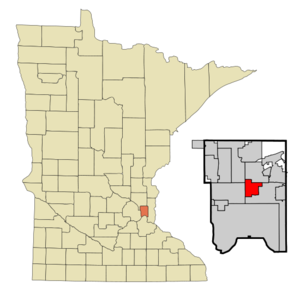- Little Canada, Minnesota
Infobox Settlement
official_name = Little Canada, Minnesota
settlement_type =City
nickname =
motto =
imagesize =
image_caption =
image_
imagesize =
image_caption =
image_
mapsize = 250px
map_caption = Location of Little Canada, Minnesota
mapsize1 =
map_caption1 =subdivision_type = Country
subdivision_name =United States
subdivision_type1 = State
subdivision_name1 =Minnesota
subdivision_type2 = County
subdivision_name2 = Ramseygovernment_footnotes =
government_type =
leader_title =
leader_name =
leader_title1 =
leader_name1 =
established_title =
established_date =unit_pref = Imperial
area_footnotes =area_magnitude =
area_total_km2 = 11.6
area_land_km2 = 10.3
area_water_km2 = 1.2
area_total_sq_mi = 4.5
area_land_sq_mi = 4.0
area_water_sq_mi = 0.5population_as_of = 2000
population_footnotes =
population_total = 9771
population_density_km2 = 944.3
population_density_sq_mi = 2445.8timezone = Central (CST)
utc_offset = -6
timezone_DST = CDT
utc_offset_DST = -5
elevation_footnotes =
elevation_m = 278
elevation_ft = 912
latd = 45 |latm = 1 |lats = 34 |latNS = N
longd = 93 |longm = 5 |longs = 19 |longEW = Wpostal_code_type =
ZIP code s
postal_code = 55109, 55117
area_code = 651
blank_name = FIPS code
blank_info = 27-37502GR|2
blank1_name = GNIS feature ID
blank1_info = 0646773GR|3
website = [http://www.ci.little-canada.mn.us/ www.ci.little-canada.mn.us]
footnotes =Little Canada is a city in Ramsey County,
Minnesota ,United States . It is an inner ring suburb of theTwin Cities . The population was 9,771 at the 2000 census.History
In 1844, French-Canadian settler Benjamin Gervais moved north from
St. Paul, MN to claim land in order to build the firstgrist mill in Minnesota that was independent from the government. Today, the large lake on the east side of Little Canada bears his name (Lake Gervais), and the formergrist mill turned City Park is recognized as the birthplace of the city. Little Canada began as the township of New Canada in 1858. In the 1950s the township was threatened by the suburban sprawl of the ensuing larger communities that were formed, such asMaplewood, MN . In 1953, the city leaders came together and established the village of Little Canada. It became a city in 1974. It was named Little Canada because the settler was Canadian.Canadian Ties
The city is not shy about its Canadian heritage. For instance, its official symbol is an initial LC on a white
fleurs-de-lis with a red Maple Leaf background, and theFlag of Canada is displayed in council chambers. [Citation
last = Scrivener
first = Lesile
author-link =
last2 =
first2 =
author2-link =
title = O Little Canada, a home away from home
newspaper =Toronto Star
pages = A1
year = 2007
date =2007-07-01 (Canada Day )
url = http://www.thestar.com/article/231344]The city itself also hosts an annual celebration named Canadian Days in early August with its sister city Thunder Bay,
Ontario .Geography
According to the
United States Census Bureau , the city has a total area of 4.5square mile s (11.6km² ), of which, 4.0 square miles (10.4 km²) of it is land and 0.5 square miles (1.2 km²) of it (10.51%) is water.Interstate Highway 35E, Interstate Highway 694, and Minnesota Highway 36 are three of the main routes in the city.
Demographics
As of the
census GR|2 of 2000, there were 9,771 people, 4,375 households, and 2,393 families residing in the city. Thepopulation density was 2,445.8 people per square mile (943.2/km²). There were 4,471 housing units at an average density of 1,119.1/sq mi (431.6/km²). The racial makeup of the city was 85.38% White, 4.20% African American, 0.58% Native American, 6.68% Asian, 0.01% Pacific Islander, 0.90% from other races, and 2.25% from two or more races. Hispanic or Latino of any race were 2.29% of the population.There were 4,375 households out of which 26.0% had children under the age of 18 living with them, 41.6% were married couples living together, 10.1% had a female householder with no husband present, and 45.3% were non-families. 36.0% of all households were made up of individuals and 11.1% had someone living alone who was 65 years of age or older. The average household size was 2.23 and the average family size was 2.96.
In the city the population was spread out with 22.1% under the age of 18, 11.0% from 18 to 24, 31.2% from 25 to 44, 22.8% from 45 to 64, and 12.9% who were 65 years of age or older. The median age was 36 years. For every 100 females there were 91.3 males. For every 100 females age 18 and over, there were 90.2 males.
The median income for a household in the city was $46,609, and the median income for a family was $61,082. Males had a median income of $41,205 versus $31,689 for females. The
per capita income for the city was $25,624. About 4.6% of families and 5.5% of the population were below thepoverty line , including 5.2% of those under age 18 and 3.4% of those age 65 or over.Government
Bill Blesener is the mayor of Little Canada, he took up this position in 2005 after serving as a member on the Council for 9 non-consecutive years (1985-1992 and 2003-2004). The Council members are Barbara Allan who filled a vacancy in 2004, John Keis filled a vacancy in 2006 and served on the Planning Commission from 1991 to 2004, and Rick Montour who joined the Council in 2001 after serving on the Planning Commission from 1996 to 2000.
Education
Little Canada is served by the [http://www.isd623.org Roseville Area School District (ISD 623)] .
References
External links
* [http://www.ci.little-canada.mn.us/ Little Canada, MN - official website]
* [http://www.rosevillereview.com/ The "Review" - newspaper site]
* [http://www.fogcap.org/ Friends of Gervais Creek and Mill Pond - park volunteer organization]
Wikimedia Foundation. 2010.


